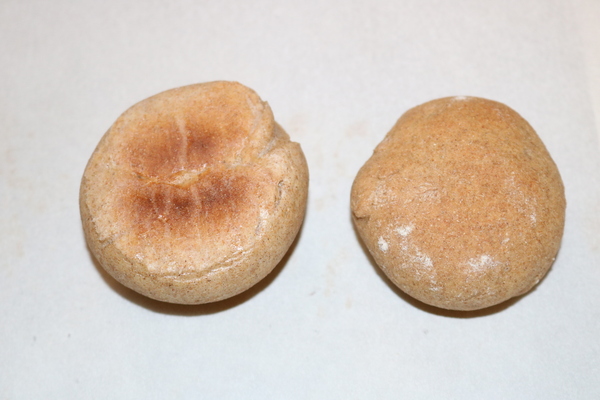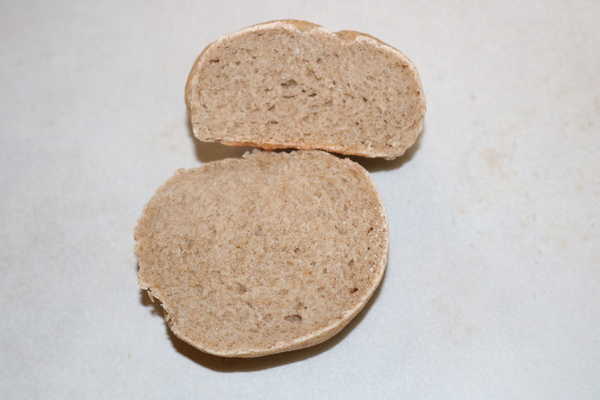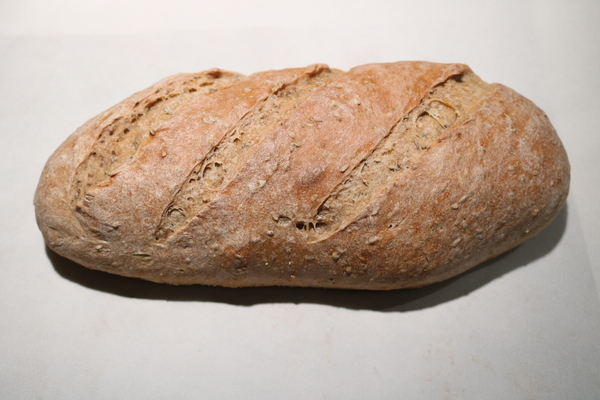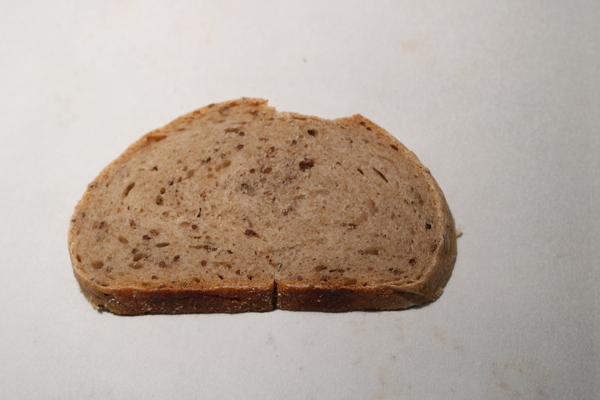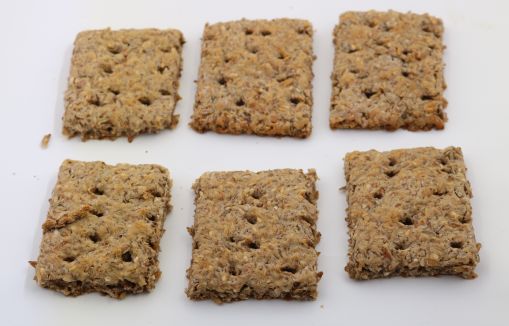Home › Forums › Baking — Breads and Rolls › Coming Through the Rye
- This topic has 138 replies, 11 voices, and was last updated 3 years, 7 months ago by
Mike Nolan.
-
AuthorPosts
-
February 8, 2020 at 6:22 pm #21110
Report on Rye Bites (Ginsberg pps 225-226):
This recipe makes 24 small rolls, about 1 1/4 ounces each after baking (36 grams). They're about 1.75 inches in diameter with a height of about 2/3 of an inch. They would probably make good slider buns if you make your sliders fairly small.
The dough was a little damp, so I wound up adding just a little more rye flour to get it to clean the bowl. They were easy to shape, and rose reasonably well. The bottoms may have gotten a little overbaked, even though I had them on the top rack in the oven, as recommended. Next time I might double sheet pan them.
This is probably the fastest recipe in the Ginsberg book, from start to finish was about 1 hour and 45 minutes. The absence of a bulk rise didn't seem to affect the final product, which was fairly light, though with a tight crumb. I've shown them sliced both horizontally and vertically.
They're a very mild rye roll, maybe almost too mild. A touch of ground caraway might give them a little more zing. I think they'd be good with a little cheese spread on them or with some corned beef; my wife thinks they'd be good with some apple butter. In other words, they're not going to be the star of the dish, but they'll complement a lot of things, making them versatile.
Attachments:
You must be logged in to view attached files.February 8, 2020 at 7:07 pm #21116Nice Rye Bites Mike.
February 14, 2020 at 10:59 pm #21297Report on Old School Deli Rye (Ginsberg pps 80-82):
The recipe appears to have some timing issues, it says to make the stage 1 sponge in the morning of the first day, then make the stage 2 sponge 12 hours later, in the afternoon, and bake about 6 hours later on day 2. I think stage 1 should be in the evening of day 1, stage 2 in the morning of day 2 and the final dough and baking in the afternoon of day 2.
It makes two loaves that I shaped as more of a batard than the football shape recommended in the text, they were 10 x 5 x 2 1/2 inches and weighed around 660 grams each (23 1/4 ounces). (My shaping method produces more slices that are similar in size, which I think is better for sandwiches.)
The dough seemed a bit softer than I expected at final shaping, though it rose reasonably well a stretch-and-fold might have tightened the dough and improved the height a little.
I think they could have been baked a little longer, the slice shows some dark areas that are areas of moisture that a little more time in the oven might have eliminated.
This recipe uses a cornstarch wash put on right after baking. I've never been a fan of cornstarch as a wash for bread, but it does not appear to have a major impact on this recipe.
The recipe uses both caraway seed and ground caraway, and they add a slight bitterness to the bread, but we like caraway in rye breads.
So far this is the best tasting loaf I've made out of the Ginsberg book, it lives up to the promise of being a New York deli-style rye. It toasts very well. I could see this bread making good Reubens, and it is likely to become part of the repertoire here.
Attachments:
You must be logged in to view attached files.February 15, 2020 at 8:38 am #21305Your bread looks nice Mike.I've used a corn starch wash before and couldn't tell any difference in the taste .
February 15, 2020 at 9:03 am #21309It may not have shown up well in the photo, but there's kind of a white tint to the crust, which is from the cornstarch wash.
The instructions said to cook the cornstarch wash until it becomes like honey in thickness, I was doing it in the microwave and it never really thickened much, whether that's because I didn't cook it enough or because I didn't boil off enough of the water is unclear. With some starches, and I think cornstarch is one of them, you can over-cook the starch and it breaks, losing thickness.
I'm fairly sure I'll be making this recipe again, with some of the others I've made so far I'm not sure I'll do that. Next time I may try doing the cornstarch wash on the stove, and possibly only putting it on one of the two loaves, to see if I can tell them apart by taste.
February 15, 2020 at 11:43 am #21317That bread looks wonderful. Too bad that Word Press doesn't have a "taste" function. 🙂 Seeing it makes me start thinking about starting a rye sour of my own....
Thanks for pointing out the timing issues. I've put sticky notes in my cookbook.
February 15, 2020 at 1:26 pm #21322It made great corned-beef-on-rye sandwiches for lunch. With a pickle slice, of course.
February 15, 2020 at 4:35 pm #21325It looks great. And the ground caraway is an interesting addition.
I go back and forth with the cornstarch glaze. I'm not sure it adds much beyond color.
February 15, 2020 at 5:48 pm #21328The cornstarch glaze is supposed to add shine, I must not be cooking it long enough, all it ever does is add a dull white finish. (But I don't understand why people like the Dutch crunch coating on breads, either.) Next time I make the old school deli bread I'm going to do one loaf with cornstarch and one without.
I did see in a thread on the BBGA forum (from 2005) in which someone said that if you toast the cornstarch before cooking it, you get even better results.
I've found an egg white glaze produces an excellent shine on rye bread, but then it's not vegan, for those who do that.
These were the first loaves I've baked with my steam tube, I thought it worked pretty well, I put in about 50 CCs of water, half right after the loaves went into the oven and the other half 2-3 minutes later, I could have put in even more, the pan was totally dry at the 10 minute mark.
I think I'll be doing the steamed loaves test on either Tuesday or Wednesday. That'll be an all-day task, with another loaf going in to the oven about every hour.
February 15, 2020 at 6:07 pm #21329I've added an index in the lead post in this thread to the 78 recipes in the Ginsberg book, as I make them I'll turn them into links to the review for that recipe.
6 and counting. There are several chapters in the book I haven't done any recipes from yet, I need to work on that so I'm not making too many similar recipes back to back.
March 20, 2020 at 10:51 pm #22170Report on Salty Rye Rolls (Ginsberg pps 141-143):
If you're looking for a fast recipe for great tasting rye rolls, this is it, under 3 hours from start to finish. It made a dozen rolls weighing about 72 grams each after baking. (They were around 80 grams each after scaling and shaping but before the caraway and salt was added.) Because of the cut on the top, they split easily into two halves. I've shown both an interior and a bottom along with a picture of an uncut roll.
Dipping the bottoms in rolled oats was a trick I haven't seen before, it keeps the bottoms from getting over-baked and adds a little oat flavor and crunch to the roll.
Mine came out a bit lighter in color than the ones in the book, that might have been due to my baking time or to the color of my rye flour. The baking time (24 minutes) might have contributed to why mine weren't overdone on the bottom.
I think they might be even better with a little caraway in the dough instead of just on top, where they don't always stay stuck on, and you need to be careful putting the salt on. The dough is only lightly salted and if the salt is uneven on the top you can get one bite that has very little salt in it and then one that's much saltier.
This is a recipe I'll definitely make again. My wife said their biggest problem was that she wanted a second one right away. (I've had 4 already.) They reminded me of some rye pretzels I've made, I think the dough might work for pretzels as well as for rolls.
Attachments:
You must be logged in to view attached files.March 20, 2020 at 10:58 pm #22173The salty rye rolls look good Mike.
March 29, 2020 at 12:25 pm #22437Report on Buttery Crispbread (Ginsberg pps 193-195):
These are 100% rye crackers, and fairly easy to make, though the recipe makes a lot of them, so I only did a half-recipe, which was one 12x18 sheet of dough. The coarse rye meal that I have might almost be a little too coarse for these, pieces of the meal get stuck in my teeth, as do some of the sesame seeds and caraway that I used.
I wound up with 24 crackers about 1/2 inch thick.
They're pretty good, and versatile. I've had several plain, one with some butter, one with peanut butter and one with pimento cheese on it, and all of the toppings worked well.
Because the rye meal is so coarse, it's hard to tell how the dough is developing. I was a little worried it was under-developed, it seemed pretty gummy for a while, but after it bulk proofed it rolled out easily, so it must have been sufficiently developed by then. (There's not a lot of gluten in rye flour.)
I used a carpenter's straightedge to trim the edges straight, you take the excess dough and roll it back in. I also used the straightedge to cut the dough into rectangles before baking them. This is a handy tool that we used a lot in chocolate school, so I picked up a 12" and a 24" one for home. They're reinforced so they're not likely to bend or warp. I've used them to cut anything that needs to have nice clean lines, including cinnamon roll dough. (These days I cut the dough into strips before rolling it up, a trick I learned a few months back.) Next time I make laminated dough, I'll use it to cut them into strips for schnecken and triangles for croissants.
Next time I make this recipe (or other crackers), I might use a little aluminum foil to tent the edges, they were threatening to get overdone before the center was fully done. After I broke them into squares, I put them back in the cooling oven to dry out a bit more overnight. Today they're pretty dry, and the recipe says they should keep well--if they last that long.
Attachments:
You must be logged in to view attached files.March 29, 2020 at 6:36 pm #22445I was looking forward to this report, Mike. I had my eye on that recipe, but by the time I could try it, the butter content concerned me. I have a barley-rye crispbread that I like which uses a lot less butter. It comes from that Swedish baking book I've mentioned. However, I had to do so much guessing with the recipe, that I think the recipe as I use and bake it could be considered my own. I use sesame seed and sunflower seed on top of them. Mine are much thinner.
I admire your use of the straight edge. That's a nifty way to get the clean lines.
-
This reply was modified 5 years, 8 months ago by
BakerAunt.
March 29, 2020 at 8:05 pm #22448It's only 75 grams of butter for the entire recipe, which makes 48 pieces, so its about 1.6 grams of butter per piece, so 3 of them is less than 1 pat of butter. You also might be able to cut the butter back, or substitute another oil.
I think these crackers could be rolled out a bit thinner, they were about 1/2 inch thick after baking. They might not have enough structure to stay together if too thin, though.
We were talking about what else we could do with these crackers. My wife suggested topping them with cheese and putting them in the microwave. I think a little cheese and sausage would go well, and I think it'd stand up to some of the stronger cheeses. Not sure how they'd be as a soup cracker, it'd probably have to be the right kind of soup. Might be interesting in a lentil or split pea soup.
I haven't tried making anything with the new plant butters, they're supposed to work just like butter in baking.
My cholesterol numbers are decent I think my last HDL was around 98, my wife's latest HDL (the good cholesterol) was like 126, her doctor said, "I run 5 miles a day and I can't get mine that high!" Our diet uses a lot of butter and other dairy and red meats. I think it's genetic.
-
This reply was modified 5 years, 8 months ago by
-
AuthorPosts
- You must be logged in to reply to this topic.
